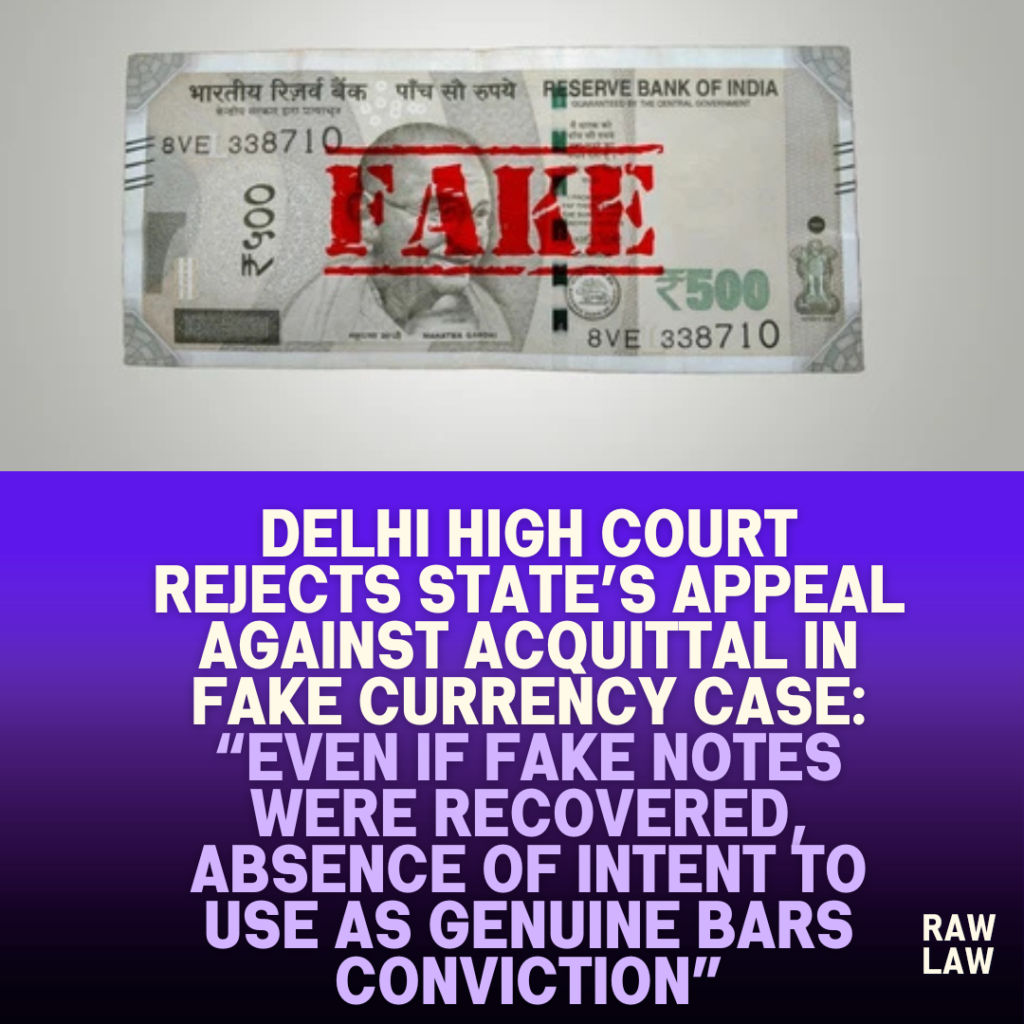Court’s Decision
The Delhi High Court dismissed the State’s leave to appeal against the acquittal of the accused under Section 489C of the IPC, upholding the trial court’s decision. Justice Amit Mahajan held that “even if it is to be presumed that the fake currency notes were recovered from the respondent, in the absence of any material to show that the same were meant to be used as genuine, no order of conviction can be passed.” The Court emphasized that contradictions in prosecution witnesses’ statements and absence of corroborative material created serious doubts, entitling the accused to benefit of such doubt.
Facts
The case arose from an incident on the night of 08/09.12.2014 when police patrolling Som Bazar Market, Pushp Vihar, noticed a crowd and discovered that one Mohd. Imran had allegedly tendered a fake ₹1,000 currency note while purchasing cloth. Upon being confronted, he attempted to flee but was apprehended. A further search yielded four more ₹1,000 notes which were also suspected to be fake. On his disclosure, Mohd. Imran allegedly revealed that he had obtained the notes from the accused. Police claimed to have arrested the accused near Shiv Shakti Public School, recovering 17 counterfeit ₹1,000 notes from him. He purportedly disclosed that the notes were supplied by one Faizul from West Bengal.
The Trial Court acquitted the accused due to contradictions in evidence and lack of corroboration, leading to the State’s present leave to appeal under Section 378 CrPC.
Issues
- Whether the prosecution proved that the accused was in possession of counterfeit currency notes with the intent to use them as genuine, as required under Section 489C IPC.
- Whether contradictions in witness testimonies and lack of corroboration undermined the prosecution’s case.
- Whether the Trial Court erred in acquitting the accused.
Petitioner’s Arguments
The State contended that:
- The Trial Court failed to properly consider that the accused was arrested on the basis of Mohd. Imran’s disclosure, linking him to the counterfeit currency.
- A formal search recovered 17 counterfeit notes from the accused.
- The accused was previously involved in another similar case and had named one Faizul as his supplier.
Respondent’s Arguments
Counsel for the accused vehemently opposed the petition, arguing that:
- There were material contradictions between the testimonies of the prosecution witnesses, particularly PW-1 Constable Sandeep and PW-8 Investigating Officer Ravi Shankar Tyagi.
- The prosecution failed to produce any evidence such as call detail records (CDRs) or seizure of the alleged mobile phone to establish the connection between the accused and Mohd. Imran.
- No independent witness supported the alleged recovery, and the prosecution’s case rested solely on uncorroborated statements.
Analysis of the Law
The High Court reiterated that in appeals against acquittal under Section 378 CrPC, the court should intervene only if there are “substantial and compelling reasons.” Citing the Supreme Court in Maharashtra v. Sujay Mangesh Poyarekar, the Court clarified that at the stage of leave to appeal, the High Court must assess whether a prima facie case or arguable point is made out, not whether the acquittal should be reversed.
Under Section 489C IPC, the essential ingredients include:
- Possession of counterfeit currency.
- Knowledge or belief that the currency is counterfeit.
- Intention to use the currency as genuine.
Mere possession without intent or supporting evidence of usage or knowledge does not satisfy the requirements for conviction.
Precedent Analysis
The Court relied heavily on:
- State of Maharashtra v. Sujay Mangesh Poyarekar, (2008) 9 SCC 475: Held that at the leave stage, the High Court must examine whether a prima facie case or arguable point exists.
- Akil v. State (NCT of Delhi), 2024 SCC OnLine Del 3242: Held that for Section 489C IPC, mens rea is essential; mere possession without intent to use as genuine is insufficient for conviction.
Court’s Reasoning
The Court observed:
- Contradictions in prosecution witnesses’ depositions, including how the accused was apprehended.
- Absence of independent witnesses and failure to produce any corroborative evidence like CDRs or mobile phones used in the alleged call between Mohd. Imran and the accused.
- The prosecution’s reliance solely on a co-accused’s disclosure without independent corroboration was insufficient.
It reiterated that the burden was on the prosecution to prove possession with intent to use as genuine. The court found the evidence fell short of this standard.
Conclusion
The Delhi High Court concluded that:
- The prosecution failed to establish the essential ingredients of the offence under Section 489C IPC.
- Material contradictions and lack of corroborative evidence created reasonable doubt.
- There was no ground to interfere with the trial court’s acquittal.
The petition for leave to appeal was dismissed.
Implications
This judgment reaffirms the principle that conviction under Section 489C IPC demands clear proof of intention to use counterfeit currency as genuine. It also underscores the appellate court’s limited scope to interfere in acquittals, emphasizing caution and the need for strong grounds to reverse trial court findings.
Also Read: Calcutta High Court Quashes FIR Against Property Buyer Alok Agarwal
